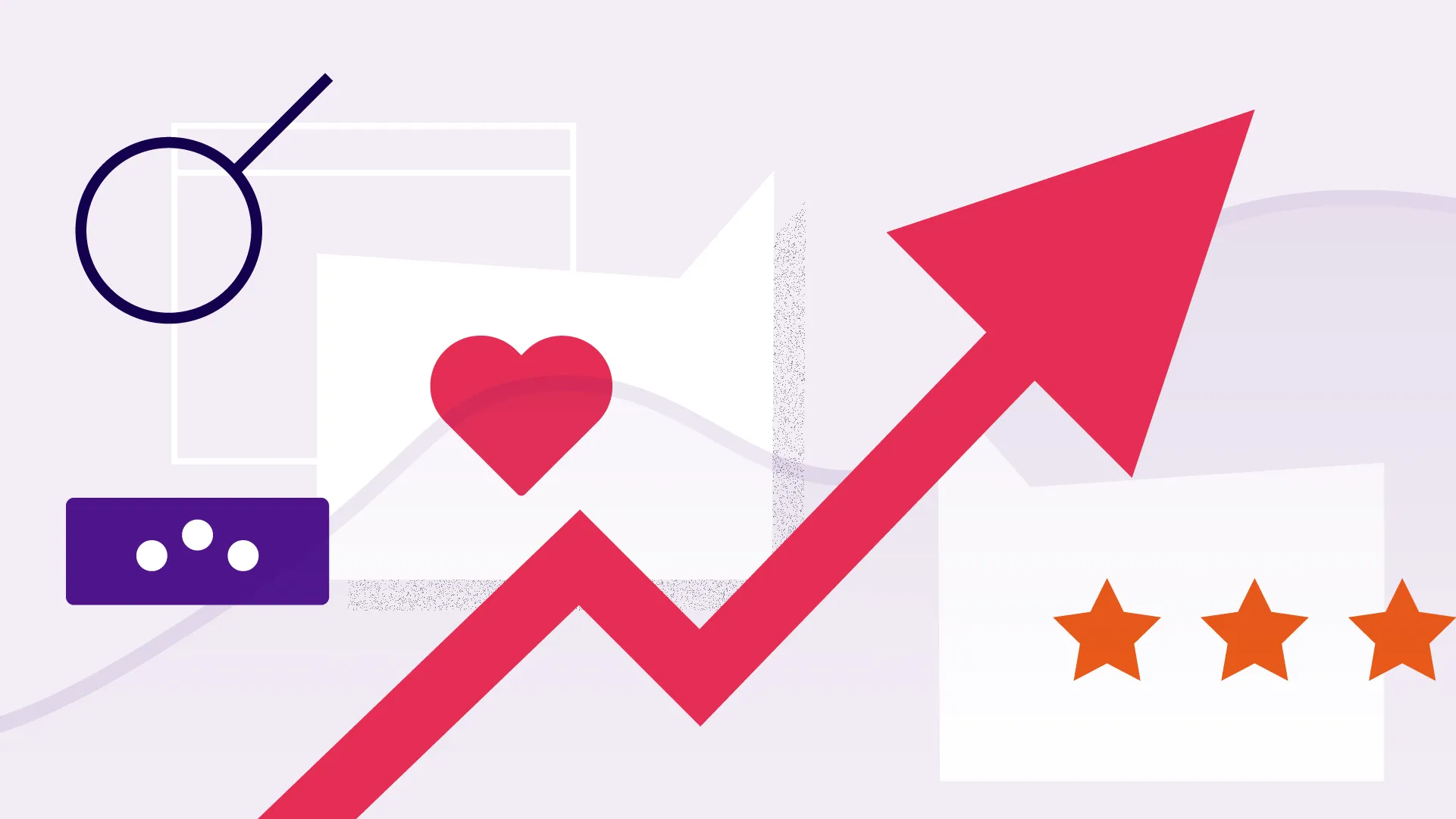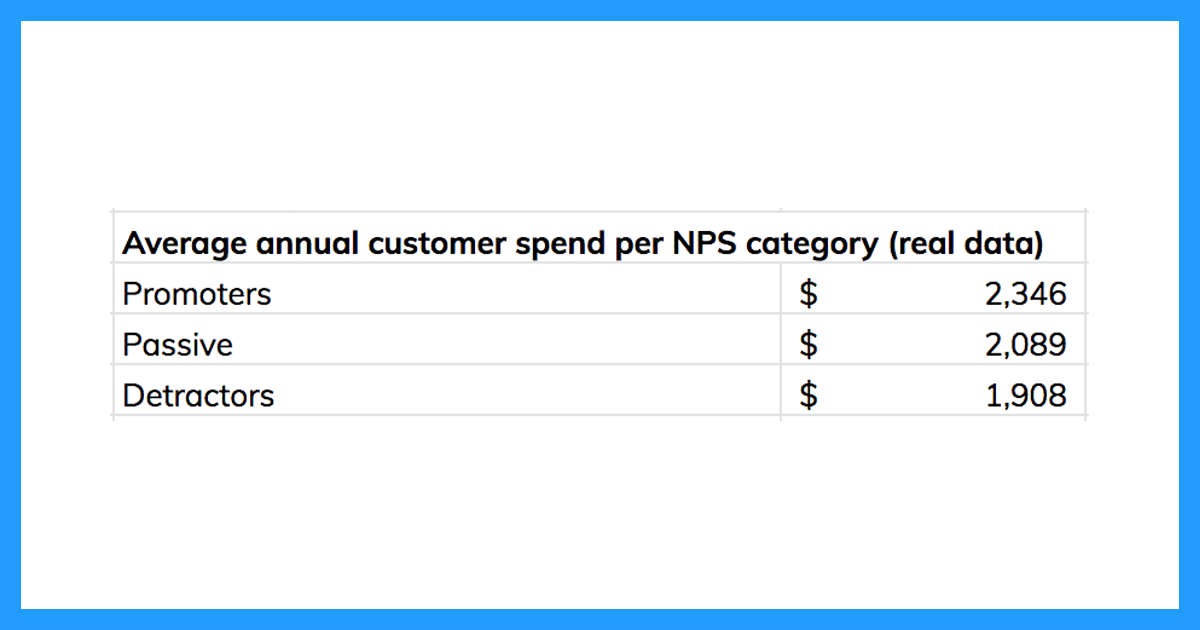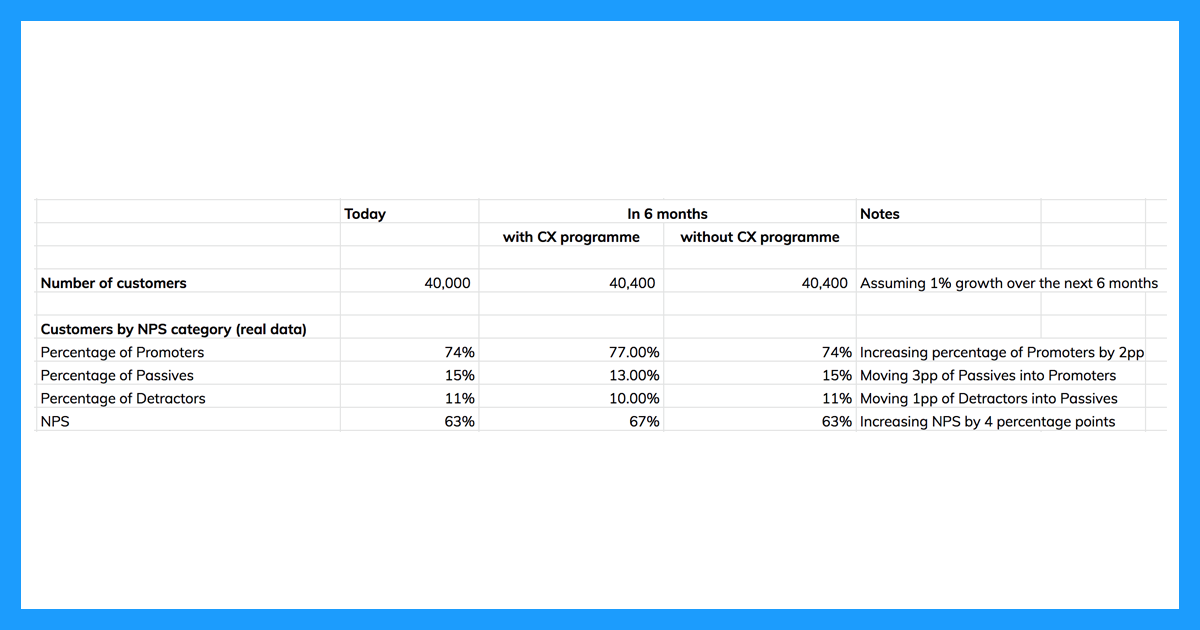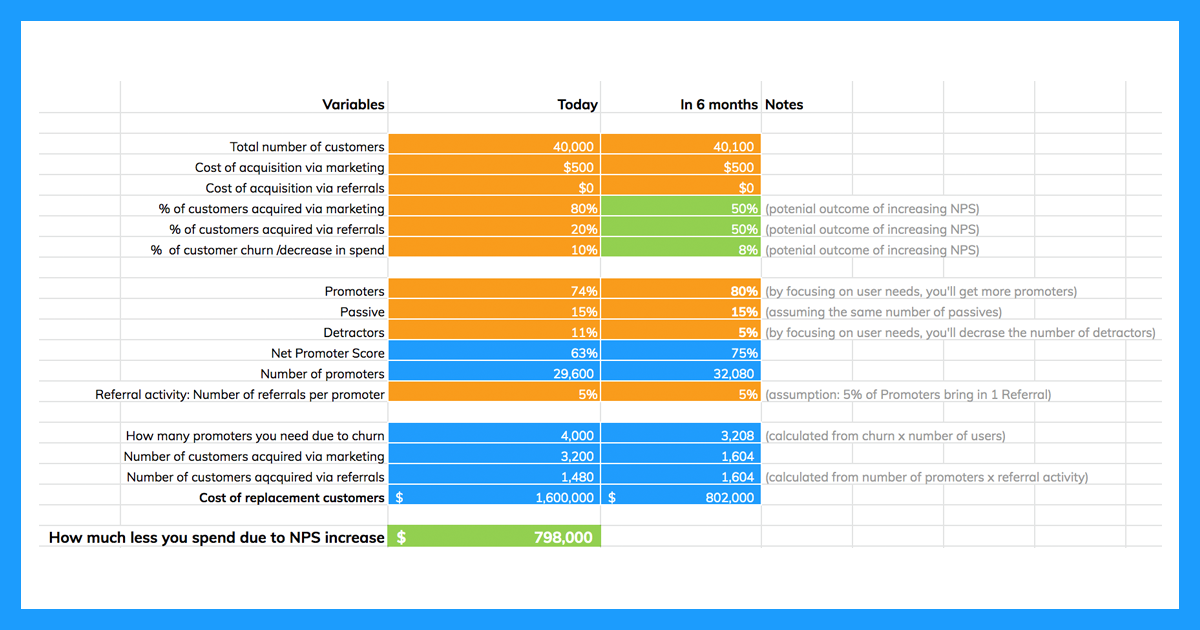
A complete and comprehensive guide to help you calculate the ROI of CX and prove the value of CX & NPS to executive teams. A customer experience ROI guide.

This blog is a comprehensive guide that will tell you everything you need to know about calculating the ROI of Customer Experience (ROI of CX) to move from insights to action.
It includes a step-by-step guide to help you calculate the ROI of CX.
We’ve also created spreadsheets just for you that you can use to calculate two financial models: the impact of Net Promoter Score (NPS) on company revenue and on customer acquisition costs.
The question on everyone's mind is: How can I prove customer experience ROI to my executive teams?
If you’re a researcher, insights or CX professional struggling to be heard by executive teams, this guide is for you.
Chapter 1: Introduction – ROI or Die!
Chapter 2: Why calculating the ROI of CX is hard
Chapter 3: The fundamentals for calculating the ROI of CX
Chapter 4: The logic behind the ROI of CX calculations
Chapter 5: How to calculate the impact of NPS on revenue
Chapter 6: How to calculate the impact of NPS on customer acquisition costs
Chapter 7: Download all the calculations
“Demo or die!” – my PhD supervisor was very clear on what is the most critical path to success in academic research.
As I later learned, in the business world, ROI (return on investment) calculations play a similar role.
You won’t be able to get executive buy-in, approval for budget, communicate success and ultimately progress in your career, unless you can estimate and then validate the ROI.
Metrics such as NPS have become currency, accepted in blind faith by many, but CX professionals still have difficulty getting companies to take action on what can move these metrics.
We believe what’s missing here is the ROI of taking action on identified metric drivers. For the remainder of the post, we’ll use NPS as our metric of choice, but you can substitute a different metric instead.
There are three key reasons why proving the ROI of CX is hard:
How can you get people to take action on insights, demonstrate program impact and gain visibility?
Showing the linkage between NPS and financial metrics first, and then demonstrating ROI is the key here.
How can we calculate the ROI of CX? By showing the impact of increases in NPS on financial metrics!
In this post, we break down different methods and give step-by-step instructions on how to create your own ROI of CX models in our pre-made spreadsheets.

ROI is easy to calculate for any investment that has immediate results.
For example, if I spend $1000 on Facebook ads, I can see within a week what kind of leads I can get from this investment.
Established businesses know the value of leads, because they know how well this convert to customers.
So, it’s easy to calculate the ROI.
You need not just a positive ROI, but ideally greater than 2 or 3.
When it comes to seeing improvements in CX, it can take months or even years to obtain the results, and it’s a multi-step process:
Step 1. Measure CX using a metric like NPS and identify its drivers. (Some companies run a driver analysis. At Thematic, we can identify drivers by showing how themes in customer feedback can impact NPS.)
Step 2. Implement improvements
Step 3. Wait for customers to notice improvements
Step 4. Measure again and evaluate change in behaviour. Are customers mentioning the same themes? What’s their impact on NPS?
Calculating ROI of CX investments can be hard because it’s not clear how long it would take to implement Step 2 and 3, and how effective might be the solution.
However, not investing into CX will result in significantly worse outcomes than not investing into advertising, such as Facebook ads.
Due to 3 reasons:
First off, you will need the following basic research completed in order for the ROI calculations to be valid.
Choose your metric. In our case, it’s NPS.
The premise behind NPS is simple… It categorizes people into those who are more likely to recommend the company to others (Promoters) and those who are less likely to do so (Passives and Detractors).
People are more likely to recommend companies where they have great experiences and where they are treated well by the company and its employees. All examples of great CX!
This should translate into financial metrics that result in faster growth: lower churn, higher customer lifetime value and decreasing cost of customer acquisition.
Given the results from your last NPS survey, you will need two sets of metrics…
Average annual spend and average number of referrals per NPS category. For example:
| NPS category | Average annual spend | Average number of new customers referred |
| Promoter | $2,000 | 3 |
| Passive | $1,000 | 1 |
| Detractor | $500 | 0 |
The referrals might be more difficult to measure, but there is no way around it. Get creative!
In B2C it could be linking customer IDs via referral codes (like in this Instacart example), in B2B it could be asking new customers who referred them. At Thematic, we keep a special field for this in our CRM.
Your numbers might not be exactly the same, but they should follow the same pattern…
~ Promoters spend more than Passives ~
~ Passives spend more than Detractors ~
If your numbers don’t follow this pattern, something isn’t right.
The most likely reason is that the NPS isn’t measured correctly.
Here are the common measurement mistakes we’ve been seeing:
I hope you get to a state where the numbers make sense.
So how does one quantify the investment into CX to help a brand to stay on top of these rapid changes in consumer expectations and behaviors?
Let’s follow a similar formula to the one we used for the ROI of Facebook ads.
Unlike in advertising on Facebook, it will take longer than a month to see an improvement in CX. To keep things simple, let’s assume it will take at least 6 months.
When estimating the ROI, the value of the CX program is the difference between the financial metrics today and the metrics that are to be realistically expected 6 months from now.
When calculating the ROI 6 months into the program, the value of the CX program is the difference between the financial metrics 6 months ago and the same metrics today.
When calculating the costs of investments into CX, the typical areas businesses invest in include:
1. Measuring NPS of their customers at various touchpoints and identifying underperforming touchpoints.
2. Benchmarking their own NPS against competitors in their industry to understand what good vs. bad performance looks like relative to a set of peer companies.
3. Identifying the drivers of NPS by doing a driver analysis, or calculating which themes have positive and negative impact on NPS.
Tip: When benchmarking data is available, insights into what works and doesn’t work for competitors is incredibly insightful.
4. Programs to drive improvements to NPS:
With the growth of NPS, many companies have been investing heavily in element 1: Introducing technologies to collect customer feedback across all different touchpoints.
Far less companies – often those only heavily invested in the Net Promoter System approach – invest in element 2, as well.
The challenge often lies in elements 3 and 4.
Companies often under-invest (or fail to invest at all) in understanding the why behind NPS (what impacts its) and in the programs to actually improve NPS over time.
Deep analysis of customer feedback will help you not only identify which programs are the most important to customers, but also whether customers have noticed an improvement in these areas over time.
Now let’s look at how to calculate the impact of NPS on revenue.
Let’s get into calculating the value of investment into CX by linking its metric, NPS, to revenue. NPS ROI.
First, you will need the total number of customers and a breakdown of the percentage of customers that fall into each NPS category.
This is an estimate but hopefully close to reality.

Next, you will need one of the metrics described in Section 1: the average spend per customer, aggregated for each NPS category.

Now you can multiply the two numbers to calculate the total revenue per NPS category.
These numbers alone are already quite insightful.

The sum is the estimated total revenue for the company and hopefully matches the actual total revenue. Make sure to cross-reference here.
So, what would be an impact of an increase in NPS by a few points?
We need to make some assumptions here.
But here is a conservative example that shows some revenue growth in any case and models two scenarios:
A small increase in NPS distributed among all NPS categories and no increase in NPS.

If we assume that the spend per customer stays the same, we arrive at the following numbers:

The increase in revenue with the CX program may not seem impressive, but it’s 42% higher than without it:
| In percent | In value | |
| Growth without CX program | 1.00% | $ 903,568 |
| Growth with CX program | 1.42% | $ 1,287,448 |
| Value attributed to CX | $ 383,881 |
You can tweak the numbers and download this spreadsheet in our free CX toolkit.
Your numbers will be especially meaningful if you can validate them against the metrics in the past.
For this specific example, the value of NPS increase of 4 percentage points is around $384K.
A good ROI of 3x would be if this company spent $127K towards that increase.
Investment into a CX program also can have positive effects on lowering customer acquisition costs.
You will need the total number of customers and a breakdown of the percentage of customers that fall into each NPS category.
In addition, you will need:
· Current CAC (cost of customer acquisition) via marketing;
· Cost of CAC via referral (in most cases it would be $0, but some companies may pay both those who refer a customer and the new customers a small amount);
· Percentage of customers acquired through marketing vs. referrals
· An estimate of how many customers promoters actually do refer (e.g. 1 in 10 promoters may actually refer new customers)
Here is an example of what these numbers might look like:

We also suggest to model churn, as customer acquisition programs typically counter-balance churn. You would get numbers like these:

In 6 months, what would happen if there were significant changes to these numbers?
If the NPS increased by 13%, most likely your churn might drop too.
Let’s say it dropped by 2 points and is now 8%. The total percentage of customers you would need to replace using marketing is 8% * 40,000 = 3208 customers.
Since the NPS increased and the number of Promoters increased by 7 percentage points to 32,080, they are now generating more referrals, a total of 1604.
That’s exactly 50%, and a significant reduction in costs required to replace churned customers.

In this scenario, the value of the CX program is almost $800,000.
You could also calculate the new CAC here, as the average across these two channels. What’s clear though is that if you do nothing, it’s unlikely that CAC is going to drop.

In this post I've just given you an overview of the data and formulas to calculate the ROI of CX. I hope this guide has provided insight into the ROI of CX, and that you can now take the necessary steps to make your own calculations.
To simply access all the formulas we've used in calculating ROI of CX, download our free guide. We've included a handy spreadsheet template to make things even easier!

Alyona Medelyan is the CEO & Co-founder of Thematic, an AI startup that uses the power of natural language processing & machine learning to help companies all over the world understand their customers.
Alyona has a PhD in natural language processing & machine learning and was inspired to write this guide after listening to countless stories of CX professionals struggling to prove the value of CX & NPS.
Join the newsletter to receive the latest updates in your inbox.